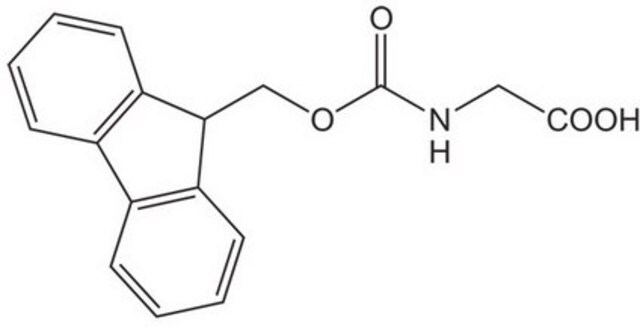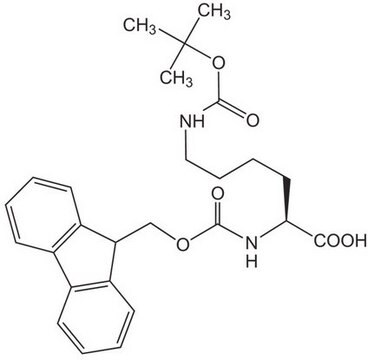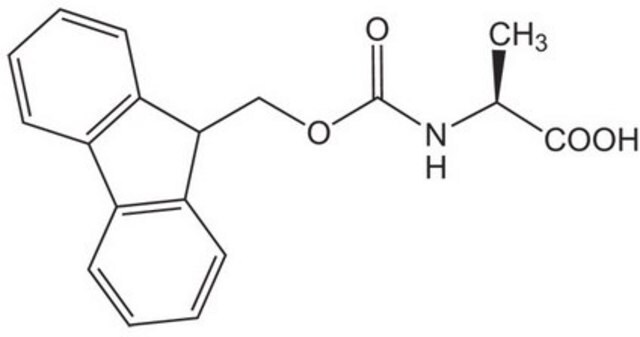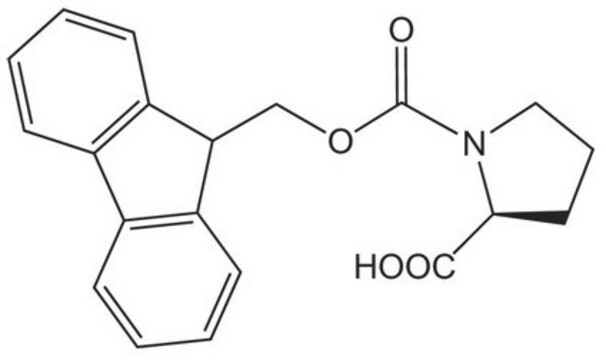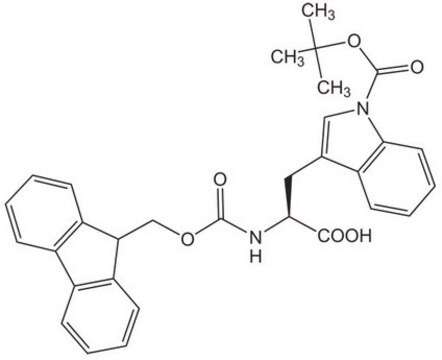8.52067
Fmoc-Arg(Pbf)-OH
Novabiochem®
Synonim(y):
Fmoc-Arg(Pbf)-OH, N-α-Fmoc-N G-(2,2,4,6,7-pentamethyldihydrobenzofuran-5-sulfonyl)-L-arginine
About This Item
Polecane produkty
Poziom jakości
linia produktu
Novabiochem®
Próba
≥98% (TLC)
≥99.0% (HPLC)
Postać
powder
przydatność reakcji
reaction type: Fmoc solid-phase peptide synthesis
producent / nazwa handlowa
Novabiochem®
mp
>65 °C
Zastosowanie
peptide synthesis
grupa funkcyjna
Fmoc
temp. przechowywania
-10 to -25°C
InChI
1S/C34H40N4O7S/c1-19-20(2)30(21(3)26-17-34(4,5)45-29(19)26)46(42,43)38-32(35)36-16-10-15-28(31(39)40)37-33(41)44-18-27-24-13-8-6-11-22(24)23-12-7-9-14-25(23)27/h6-9,11-14,27-28H,10,15-18H2,1-5H3,(H,37,41)(H,39,40)(H3,35,36,38)/t28-/m0/s1
Klucz InChI
HNICLNKVURBTKV-NDEPHWFRSA-N
Powiązane kategorie
Opis ogólny
The standard derivative for the introduction of Arg in Fmoc SPPS [1,2]. The Pbf side-chain protecting group is removed with TFA approximately 1-2 times faster than Pmc.In the preparation of peptides containing both Arg and Trp, it is recommended that this derivative is used in conjunction with Fmoc-Trp(Boc)-OH (852050).
Associated Protocols and Technical Articles
Fmoc-amino acids for Peptide Production
Cleavage and Deprotection Protocols for Fmoc SPPS
Literature references
[1] L. A. Carpino, et al. (1993) Tetrahedron Lett., 34, 7829.
[2] C. G. Fields, et al. (1993) Tetrahedron Lett., 34, 6661.
Zastosowanie
- Syntheses of cyanophycin segments for investigations of cell-penetration: Describes the synthesis process and overall yields for steps from Fmoc-Arg(Pbf)-OH to Adp building blocks. (M Grogg, D Hilvert, D Seebach, 2019).
- Revisiting NO2 as Protecting Group of Arginine in Solid-Phase Peptide Synthesis: Compares the stability of Fmoc-Arg(Boc) 2 -OH with Fmoc-Arg(Pbf)-OH in solvents over time. (M Alhassan, A Kumar, J Lopez, F Albericio, 2020).
- Gene delivery of PAMAM dendrimer conjugated with the nuclear localization signal peptide originated from fibroblast growth factor 3: Discusses a conjugation reaction involving Fmoc-Arg(pbf)-OH in gene delivery systems. (J Lee, J Jung, YJ Kim, E Lee, JS Choi, 2014).
Powiązanie
Komentarz do analizy
Appearance of substance (visual): powder
Colour index (0,5 M in DMF): ≤ 150 Hazen
Identity (IR): passes test
Enantiomeric purity: ≥ 99.8 % (a/a)
Purity (HPLC): ≥ 99.0 % (a/a)
Fmoc-ß-Ala-OH (HPLC): ≤ 0.1 % (a/a)
Fmoc-ß-Ala-Arg(Pbf)-OH (HPLC): ≤ 0.1 % (a/a)
Fmoc-Arg(Pbf)-Arg(Pbf)-OH (HPLC): ≤ 0.1 % (a/a)
Fmoc-Arg-OH (HPLC): ≤ 0.1 % (a/a)
Assay free amino acid (HPLC): ≤ 0.2 %
Purity (TLC(011C)): ≥ 98 %
Purity (TLC(157B)): ≥ 98 %
Solubility (12,5 mmol in 25 ml DMF): clearly soluble
Assay (acidimetric): ≥ 90.0 %
Water (K. F.): ≤ 2.0 %
Ethyl acetate (HS-GC): ≤ 1.0 %
Acetate (IC): ≤ 0.02 %
To see the solvent systems used for TLC of Novabiochem® products please click here.
Informacje prawne
Nie możesz znaleźć właściwego produktu?
Wypróbuj nasz Narzędzie selektora produktów.
Kod klasy składowania
11 - Combustible Solids
Klasa zagrożenia wodnego (WGK)
WGK 3
Temperatura zapłonu (°F)
Not applicable
Temperatura zapłonu (°C)
Not applicable
Certyfikaty analizy (CoA)
Poszukaj Certyfikaty analizy (CoA), wpisując numer partii/serii produktów. Numery serii i partii można znaleźć na etykiecie produktu po słowach „seria” lub „partia”.
Masz już ten produkt?
Dokumenty związane z niedawno zakupionymi produktami zostały zamieszczone w Bibliotece dokumentów.
Klienci oglądali również te produkty
Nasz zespół naukowców ma doświadczenie we wszystkich obszarach badań, w tym w naukach przyrodniczych, materiałoznawstwie, syntezie chemicznej, chromatografii, analityce i wielu innych dziedzinach.
Skontaktuj się z zespołem ds. pomocy technicznej
